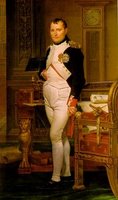Empire and regency fashion
 The Directoire and Empire Period (1790 to 1820) is named after the French executive council, or Directoire, that was established after the Reign of Terror. This council of five men was in power until Napoleon Bonaparte staged a coup d’etat and became first consul. The Empire Period refers to Napoleon’s era, when he was Emperor of France.
The Directoire and Empire Period (1790 to 1820) is named after the French executive council, or Directoire, that was established after the Reign of Terror. This council of five men was in power until Napoleon Bonaparte staged a coup d’etat and became first consul. The Empire Period refers to Napoleon’s era, when he was Emperor of France.The silhouette during this period derives its inspiration from classic Greek and Roman times, and the typical look was short-sleeved, with an elevated waistline located under the bust, and fabric clinging to and revealing the shape of the body. Typical fabrics used were cotton, muslin, and silk in whites, pastels, and delicate patterns. The women are wearing turbans, which were especially fashionable after Napoleon’s invasion of Egypt. The increased decoration on the two gowns is indicative of late Empire style.
In this period, fashionable women's clothing styles were based on the Empire silhouett
 e — dresses were closely-fitted to the torso just under the breasts, falling loosely below. In different contexts, such styles are commonly called "Directoire" (referring to the Directory which ran France during the second half of the 1790s), "Empire" (referring to Napoleon's 1804-1814/1815 empire, and often also to his 1800-1804 "consulate"), or "Regency" (most precisely referring to the 1811-1820 period of George IV's formal regency, but often loosely used to refer to various periods between the 18th century and the Victorian).
e — dresses were closely-fitted to the torso just under the breasts, falling loosely below. In different contexts, such styles are commonly called "Directoire" (referring to the Directory which ran France during the second half of the 1790s), "Empire" (referring to Napoleon's 1804-1814/1815 empire, and often also to his 1800-1804 "consulate"), or "Regency" (most precisely referring to the 1811-1820 period of George IV's formal regency, but often loosely used to refer to various periods between the 18th century and the Victorian).These 1795-1820 fashions were quite different from the styles prevalent during the most of the rest of the 18th and 19th centuries, when women's clothes were generally tight against the torso from the natural waist upwards, and heavily full-skirted below (often inflated by means of hoop-skirts, crinolines, panniers, bustles, etc.). The high waistline of 1795-1820 styles took attention away from the natural waist, so that there was then no point to the tight "wasp-waist" corseting often considered fashionable during other periods. Thus during the 1795-1820 period, it was often possible for middle- and upper-class women to wear clothes that were not very confining or cumbersome, and still be considered decently and fashionably dressed.


0 Comments:
Post a Comment
<< Home